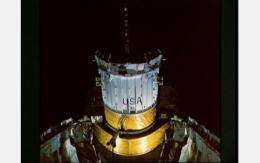Satellite Used in Polar Research Enters Retirement

(PhysOrg.com) -- After a long career providing communications support, NASA's Tracking and Data Relay Satellite (TDRS) 1 is retiring. From 1983 to 1998, TDRS-1 allowed NASA to talk to other satellites in orbit. From 1998 to 2009, NASA reassigned TDRS-1 to support the National Science Foundation and its U.S. Antarctic Program partners to perform scientific, educational, and operational endeavors.
Launched aboard space shuttle Challenger's maiden voyage in April 1983, TDRS-1 was the first satellite used to support launches from NASA's Kennedy Space Center in Florida in the early 1990s, returning real-time telemetry. It closed a dead zone over the Indian Ocean where there previously was no communication, providing 100 percent coverage of the space shuttle and low Earth orbiting satellites. Because of its orbit, the satellite was able to see both the North and South Poles.
The first Internet connection and live webcast from the North Pole were transmitted through TDRS-1. It relayed the first Pole-to-Pole phone call that connected the South Pole and the North Pole. And it supported the first global television broadcast from the South Pole Station, the ABC-BBC-WGBH world-wide Millennium television broadcast.
In cooperation with NSF, an uplink/downlink station for TDRS-1 was installed near the exact South Pole in January 1998. This terminal gave scientists at NSF's Amundsen-Scott South Pole Station year-round ability to return high volumes of scientific data to the continental U.S. for about five hours daily. During its North and South Pole visits, TDRS-1 routinely transmitted tens of gigabytes of science research data daily to university researchers worldwide.
TDRS-1 was instrumental in supporting innovative astronomy and astrophysics research programs at the South Pole Station, including the one-of-a-kind IceCube Neutrino Observatory and the South Pole Radio Telescope. IceCube uses the polar ice cap to form a detector capable of sensing sub-atomic particles from deep space. The Radio Telescope takes advantage of the South Pole's high altitude and extremely dry air to conduct sky surveys studying cosmic microwave background radiation.
During a medical emergency in 1999 at Amundsen-Scott Station, TDRS-1's high-speed connectivity allowed station personnel to conduct telemedicine conferences, and doctors in the U.S. guided Dr. Jerri Nielsen, who was diagnosed with breast cancer, in performing a self-biopsy and administering chemotherapy. In 2002, doctors and TDRS-1 again performed a telemedicine conference with the research station, this time to assist with knee surgery on a meteorologist spending the winter in Antarctica.
In 2000, TDRS-1 successfully supported an extended NSF/Coast Guard science expedition to the Gakkel Ridge just below the North Pole.
On June 13, 2010, the first-of-its-kind communications satellite arrived at its final destination, about 22,500 miles above the planet. The change of orbit maneuver began on June 5 and moved TDRS-1 from its geosynchronous orbit 22,300 miles above Earth to its final destination, about 200 miles above its previous orbit. The process took 8 days to ensure the satellite reached its final destination without adversely affecting its small maneuvering thrusters. Once the final orbit was established and the remaining fuel was removed to prevent potential accidents, NASA shut down the satellite on June 26. NASA plans eventually to retire the entire TDRS constellation in this manner in order to protect other geo spacecraft from orbital debris.
Since TDRS-1 entered service, NASA has placed eight other Tracking and Data Relay Satellites into specific geosynchronous orbits. The first six were built by TRW Inc (now Northrop Grumman Corp). Boeing Satellite Systems also built three enhanced satellites. The second TDRS satellite was lost with space shuttle Challenger in January 1986. The Space Network continues to use the TDRS System to relay data and communications from more than 15 customers, including the space shuttle, the International Space Station, the Hubble Space Telescope and NSF and the South Pole Station.
Provided by National Science Foundation

















